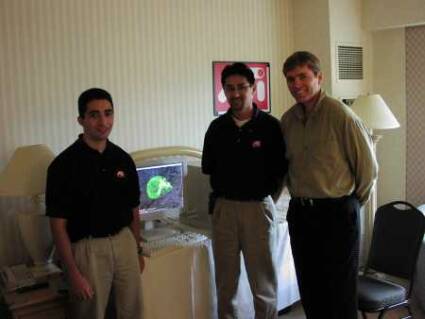Meltdown 2001 - ATI's R200 Countdown Begins
SMARTSHADER - Up The Pixel Shader Ladder
By now, you have seen the announcement about ATI's SMARTSHADER technology, which George covered in our Hard News section here . He linked through to ATI's online White Paper on the technology and it's a little lightweight on the technical detail, but worth a read for an overview.
At Meltdown, I met with ATI in their suite and got the full blown PowerPoint blast on the technology and some live demos. Present were David Nalasco, Technololgy Marketing Manager, Toshi Okumura, Product Marketing Manager, and John B. Challinor II, Director of PR for ATI.
David, Toshi, and John from ATI - desperately trying to hide the box that holds the key to the kingdom of R200
The tack of the presentation wasn't all that original to begin with. In the past, it was Toy Story graphics in real time. Now, ATI is pushing for Final Fantasy graphics in real time. It's a nice marketing message, but the real story here seems to be that ATI has jumped ahead of Nvidia on the hardware curve by adding its own enhancements to pixel shading in DirectX, and got them incorporated in DirectX 8.1. Just for the sake of an overview, the diagram below is the DirectX 3D pipeline. There have been an awful lot of articles on the 3D graphics pipeline. For the sake of hardware enthusiasm we can probably simplify things here. Vertex shaders are the T&L segment, and pixel shaders are the rasterizers. Prior to DirectX 8, T&L and rasterizer functions were fixed in hardware, but in the new model, programmers can have access to an almost unlimited number of visual effects by plugging in their own routines into the pipeline.
This diagram of the DirectX Graphics Architecture, courtesy of Microsoft, lays out the basic graphics pipeline in the newly minted, highly programmable world of DirectX 8.1, and beyond. ATI's SMARTSHADER technology appears to give ATI compatibility with all three new pixel shader models in DirectX 8.1, ps 1.2, 1.3, and the forward looking ps 1.4. On the other hand, GeForce3 seems to stop be more focused on 1.2 and 1.3, lacking the extra texture stages and registers that 1.4 brings to the table. In reality, this does not have a short term impact on the quality of real world graphics, in other words, game developers have a long way to go to get with the program on DirectX 8.1 so, you're not going to get left out with either Nvidia or ATI products.
Get Tom's Hardware's best news and in-depth reviews, straight to your inbox.
Current page: SMARTSHADER - Up The Pixel Shader Ladder
Prev Page Introduction Next Page SMARTSHADER - Up The Pixel Shader Ladder, Continued
